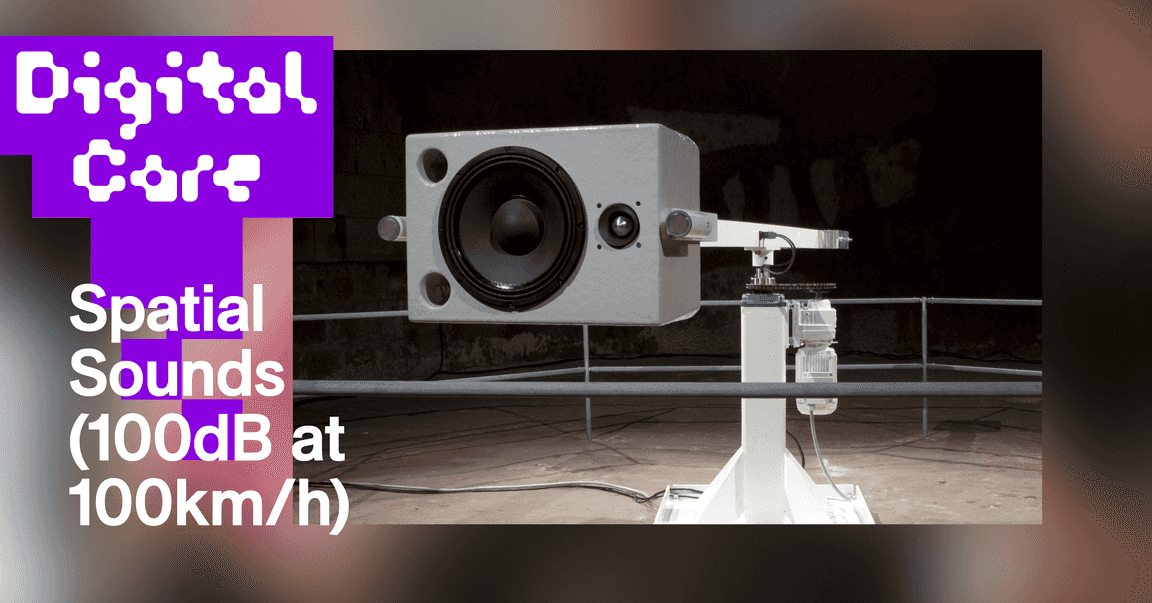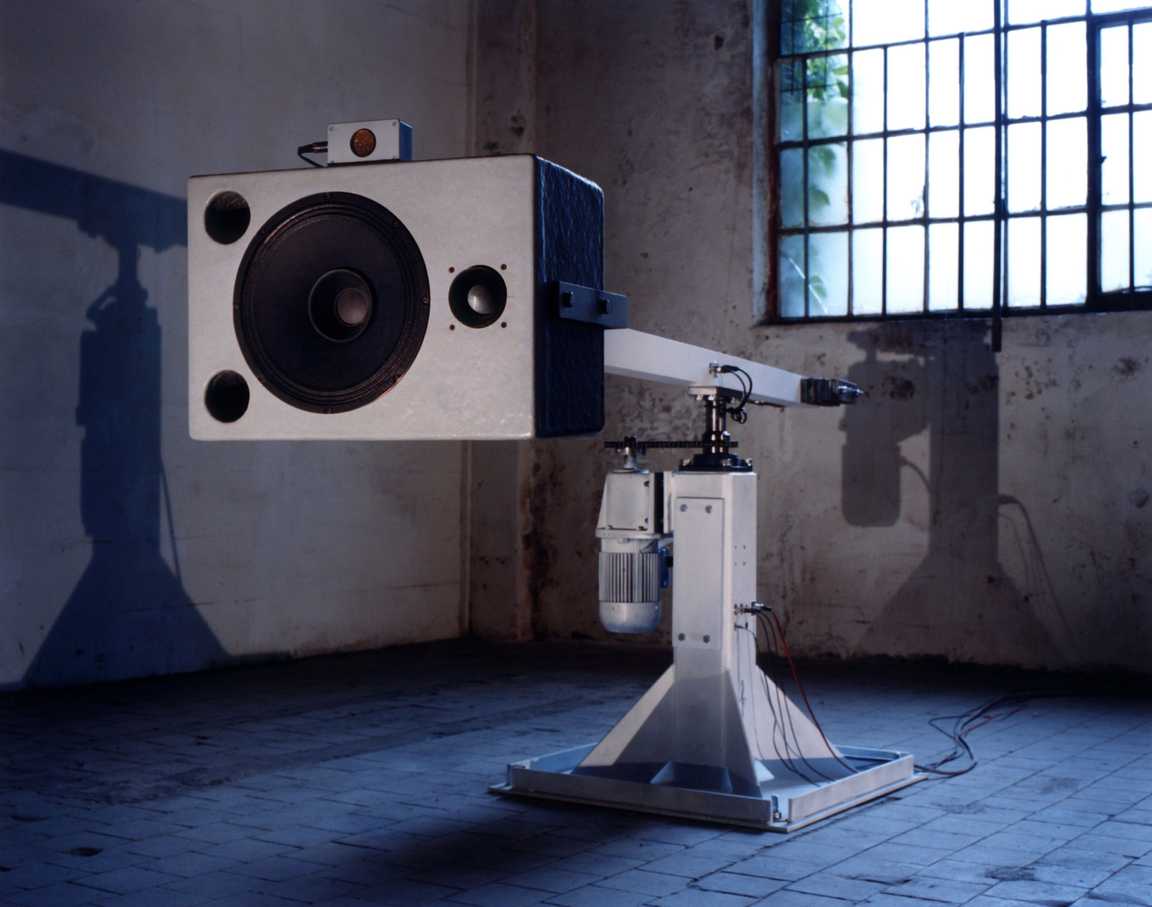
Digital Care: Spatial Sounds
The sixth and final event in the Digital Care series, focusing on Marnix de Nijs’ and Edwin van der Heide’s Spatial Sounds (100dB at 100km/h).
On 12 May, the last edition of our Digital Care programme highlighted Spatial Sounds (100dB at 100km/h) (2000) by Marnix de Nijs and Edwin van der Heide. This interactive installation presented at the exhibition REBOOT: Pioneering Digital Art, questions the present-day role of the machine, asking whether we control machines or machines control us. Spatial Sounds (100dB at 100km/h) highlights the threatening but also seductive aspects of autonomous technologies and asks questions about the role of humans in technological developments. Who’s in control, the human or the machine?
Programme Details
This Digital Care event on 12 May started at 13:30 in the exhibition space at Nieuwe Instituut. Here, Spatial Sounds was activated for 30 minutes, allowing for interaction. Talks and a discussion followed, starting at 14:15 in Room 1. Sanneke Huisman (curator REBOOT and LI-MA) introduced Digital Care, Edwin van der Heide and Marnix de Nijs talked about the practice and process behind the work. Ksenia Fedorova (assistant professor, Leiden University) and Yvonne Dröge Wendel (artist and Head of Fine Arts, Rietveld Academie) offered perspective on Spatial Sounds and its relation to the notions of humans and non humans, man-machine interaction, auditory perception. This was followed by a Q&A in which the audience was invited to join the conversation.
About Spatial Sounds (100dB at 100km/h)
Spatial Sounds (100dB at 100km/h) is an interactive audio installation by artists Marnix de Nijs and Edwin van der Heide. The sensor-equipped loudspeaker rotates and scans the environment for visitors. The installation responds to their behaviour with different patterns of movement and expressive, ever-changing sound. As the number of visitors increases, their movement manipulates the sounds of the installation and determines the speaker’s motion, sounds, and speed. As the activity increases in the installation space, the speaker begins to spin faster, up to speeds of 100km/h, creating a game of attraction and repulsion between humans and machines.
Spatial Sounds consists of a speaker on a long arm with a counterweight at the other end. The arm can spin, and can be regulated between very slow and very high speeds, with a maximum of 100 km/h. A high-speed distance-measuring sensor is mounted close to the speaker and measures the surrounding space. It scans any objects and visitors in this space. Because it is spinning, it creates a spatial depiction of the space, resulting in a continuously changing, dynamic map, rather similar to traditional radar.
The sound and movements of Spatial Sounds are generated in real-time, and the algorithms for generating these are defined very precisely. However, the actual sounds depend very much on what visitors do with the installation. On top of the speaker is a sonar sensor that measures the distance between visitors and objects and the speaker. The sensor takes its measurements from a beam facing away from the speaker, and there is also an angle sensor mounted on the axis of the installation. The data from both sensors are transmitted to the computer that generates the sound. When the installation is placed in a room, it first learns the shape of this room while it is still empty. In this way, it can distinguish between people in a space and the space itself. Thereafter, the computer is able to recognize the various visitors to the space.

Spatial Sounds by Marnix de Nijs and Edwin van der Heide. Ars Electronica. 2000-2001.
About the Artists and Speakers
Edwin van der Heide is an artist, composer and performer. The central theme of his work is the interaction of sound and space. In 1992, he graduated from the Institute of Sonology at the Royal Conservatory in The Hague and in 1993 he co-founded the group Sensorband with Zbigniew Karkowski and Atau Tanaka. His current work is hard to define within the traditional terminology of music, sound art, or media art, as he is always working at the edge of his medium. Edwin teaches part-time at the Interfaculty Sound & Image at the Royal Conservatory and Royal Academy of Art in The Hague, and has guest-lectured, performed, and shown installations extensively in the Netherlands and abroad.
Marnix de Nijs is a Dutch installation artist and considered a pioneer of Dutch media art since the mid 1990s. He makes use of high-concept mechanics, software, and ever-evolving technologies to create interactive artworks that play with the viewer’s perception of image, sound, and movement. De Nijs’ work explores how contemporary technological culture acts upon our senses and continuously shapes our modes of perception. To create his technologically complex installations, De Nijs often relies on close collaborations with media labs, universities, and highly skilled developers/engineers. His work has been widely exhibited at international art institutes, museums and festivals. In 2005, he collected the prestigious Witteveen & Bos Art and Technology Prize, for his entire oeuvre.
Ksenia Fedorova (PhD) is Assistant Professor at Leiden University. She is the author of Tactics of Interfacing: Encoding Affect in Art and Technology (MIT, 2020) and the co-editor of Media: Between Magic and Technology (2014, in Russian), her other publications appeared in Leonardo Electronic Almanac, Media & Culture Journal, Acoustic Space, and various edited volumes. Ksenia’s interests encompass media art theory and history, aesthetics, philosophy, art, science and technology studies, with a focus on the effects of technologies on human perception and interaction.
Yvonne Dröge Wendel (1961) is an artist and the head of the department of Fine Arts at the Gerrit Rietveld Academie. She is concerned with the relational and performative abilities of things, a theme that touches on present-day questions about our relationship to the (technological) world around us. She sets up experimental encounters and aims to capture what it is that objects actually do. Rethinking the subject-object distinction and reworking our understanding of what it is for humans and non-humans to constitute a world is the main focus point of her artistic practice. Dröge Wendel was awarded the prestigious Dr. A.H.Heineken Prize for Art. She initiated the Architecture of Interaction, a project realised by a group of five artists and theorists who have set out to develop a toolbox for discussing processes, meanings and effects of interactive work.
Sanneke Huisman (1985) is trained as an art historian, and works as writer, critic and curator with a focus on media art. She is co-editor of A Critical History of Media Art in the Netherlands: Platforms, Policies, Technologies (2019). At LI-MA, she is active as a curator; recent projects include Cultural Matter (2017-2020), Digital Canon of the Netherlands (2017-2019) LIMA Online (2020-2021) and Mediakunst op Wikipedia (2021-2023). Together with Klaas Kuitenbrouwer (Nieuwe Instituut), she is co-curator of REBOOT: Pioneering Digital Art. Furthermore, she writes about contemporary art for magazines and exhibition catalogs, including Metropolis M and Centraal Museum Utrecht, is a guest lecturer and works as an advisor at Cultuurloket DigitALL.
Digital Care
Digital Care presents collaborative care for digital artworks. From March 2023 until May 2024, iconic works, including the_living (1997-1998) by Debra Solomon, Ideofoon I (1970-2013) by Dick Raaijmakers and Institute of Artificial Art Amsterdam (1990-present) by Remko Scha, were researched and shown in public programmes across the Netherlands. In an open process together with artists, producers, scholars, and the public, we explored what it means to present these works today - and in the future.
The Digital Care trajectory functioned as a strong basis for contextualising and preparing the public exhibition REBOOT: Pioneering Digital Art, presented by Nieuwe Instituut and LI-MA. REBOOT exhibits key works from the period 1960-2000 and presents new works by contemporary makers. The exhibition presents the impact of digital technology in art and society and builds on the Digital Canon of the Netherlands, compiled by experts in 2017-2019 commissioned by LI-MA. REBOOT runs from 7 October 2023 to 12 May 2024 at Nieuwe Instituut.
Digital Care and REBOOT are supported by Creative Industries Fund NL, Mondriaan Fund, and Network Archives Design and Digital Culture.






